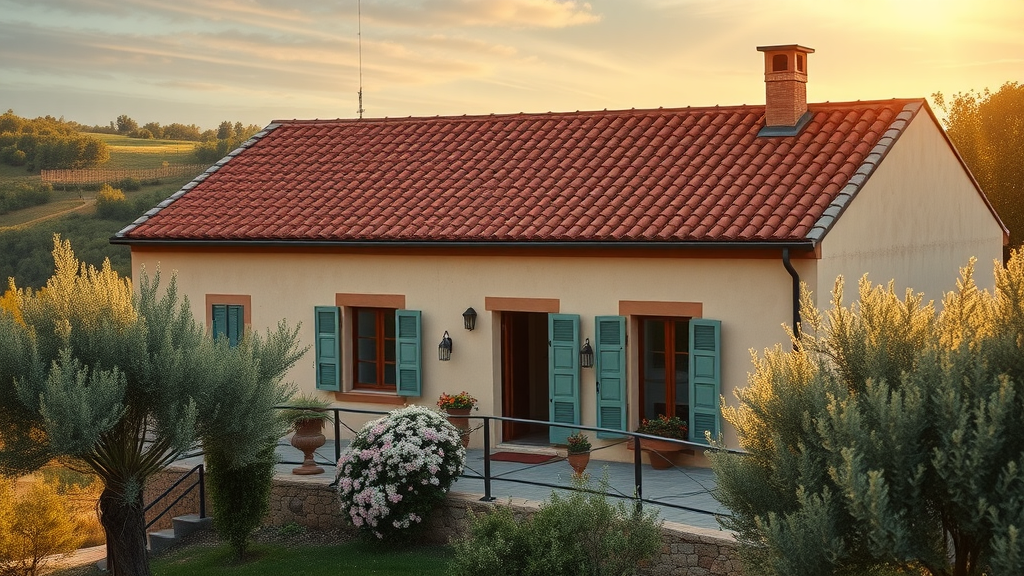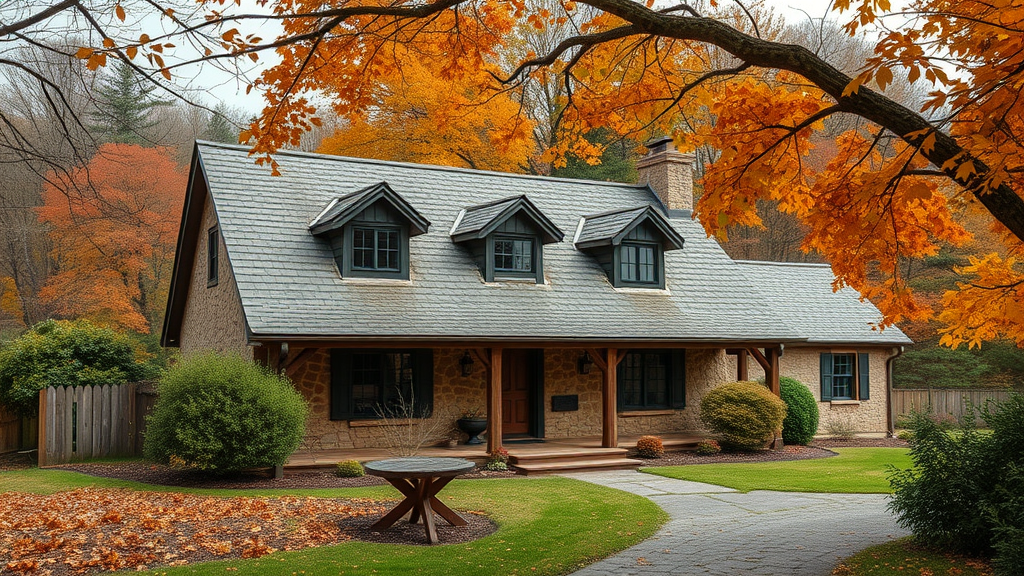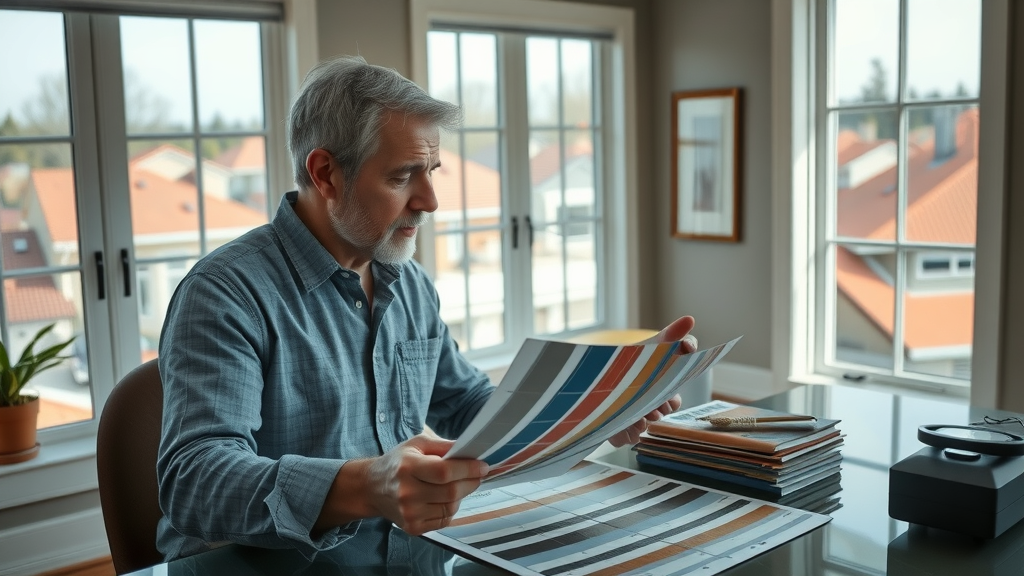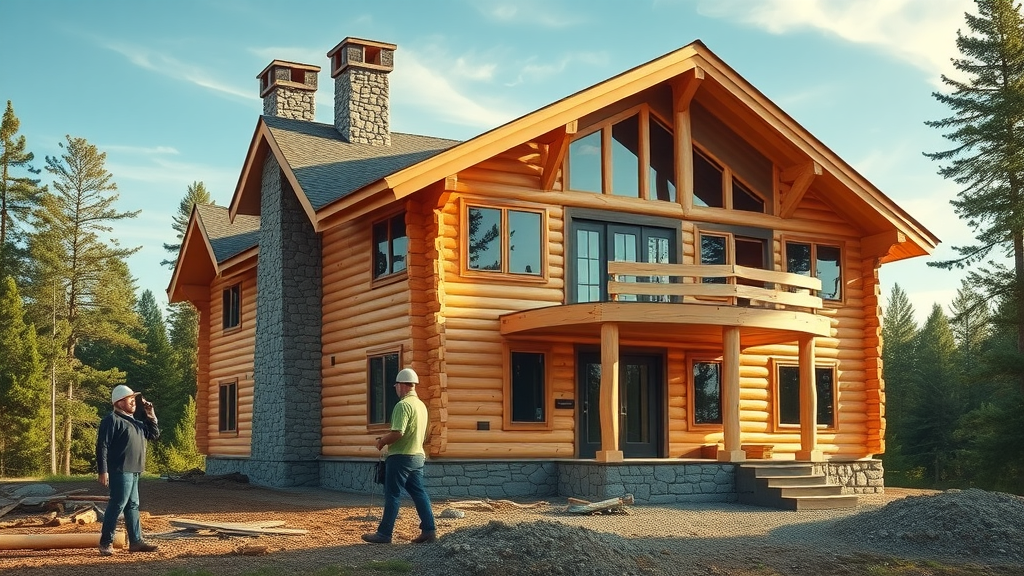Did you know that 95% of roofing failures occur because of choosing the wrong roofing materials? Selecting the right roof material doesn't just protect your property—it safeguards decades of comfort, value, and peace of mind for your entire family. In this comprehensive guide, you’ll uncover how roofing materials can define your home’s curb appeal, longevity, and even the value at resale. Whether renovating, building, or planning a roof replacement, being informed means investing with confidence.
Discover Why Choosing Quality Roofing Materials Is Critical
‘A staggering 95% of roofing failures occur due to the wrong choice of roofing material, costing homeowners thousands in unexpected repairs.’
- Explore how advanced roofing materials boost home value and longevity
- Understand costs versus benefits in today’s market
- Identify which roofing materials align with your climate and needs

Comprehensive Comparison: Types of Roofing Materials
When it comes to selecting roofing materials, you face a wide range of choices, each with unique characteristics, prices, and benefits. Understanding these differences helps you not only select the most suitable option for your region and budget but also ensures your investment lasts for decades. Let’s compare the most popular types of roof materials—such as asphalt shingles, metal roof systems, tile roof materials, and more—so you’ll know exactly what to expect in terms of cost, durability, maintenance, and lifespan.
Many homeowners might rush to the most common or cheapest type of roofing, but with weather extremes, UV exposure, and other environmental considerations, using quality roofing materials can truly pay off. The next section breaks down individual roof materials side by side, while delving into how these choices perform in the real world. By the end, you’ll be equipped with the data and insights needed to make the best possible decision for your home’s rooftop protection.
| Roofing Material | Average Lifespan | Cost (Installed per Sq Ft) | Durability | Maintenance |
|---|---|---|---|---|
| Asphalt Shingles | 15-30 years | $3.00 - $5.50 | Moderate | Low to Moderate |
| Metal Roof (Standing Seam/Metal Shingles) | 40-70 years | $7.00 - $14.00 | High | Low |
| Tile Roofing (Clay/Concrete Tile) | 50-100 years | $10.00 - $22.00 | Very High | Low |
| Wood Shake & Wood Shingle | 20-40 years | $7.00 - $13.00 | Moderate | High |
| Slate Roof | 75-150 years | $20.00 - $40.00 | Extremely High | Low |
| Synthetic (Rubber/Plastic/Composite) | 30-50 years | $8.00 - $15.00 | High | Low |
Reviewing Popular Roofing Materials: Asphalt Shingles, Metal Roof, Tile Roof, and More
- Asphalt shingle pros/cons: Affordable, widely available, easy to install, but has a shorter lifespan and may require more frequent replacement.
- Metal roof varieties: Includes standing seam and metal shingles—offering superior fire resistance and longevity but a higher initial cost.
- Tile roofing features: Gorgeous aesthetics, extreme longevity, good for hot climates, but heavy and needs strong support.
- Wood and synthetic options: Natural charm, eco-friendliness (wood shakes) or advanced durability (synthetics), but maintenance requirements and cost vary widely.
Asphalt Shingles: The Time-Tested Roofing Material
Asphalt shingles remain one of the most popular roofing materials across North America for good reason—they’re affordable, relatively easy to install, and offer a wide variety of colors and textures. Advancements in manufacturing have made today’s asphalt shingle options more durable and attractive, allowing homeowners to mimic the look of wood or slate without the extra cost.
However, asphalt shingles do have limitations. While their moderate lifespan (typically 15-30 years) makes them the most common roof replacement material, they’re generally more prone to storm and wind damage than metal or tile roofing. For homeowners seeking a balance of economy and style in roofing materials, asphalt remains a compelling choice—but be sure to understand lifespan and replacement signs before making a decision.
Key Features and Costs of Asphalt Shingle Roofing Materials
Asphalt shingles are composed of fiberglass or organic bases saturated with asphalt and topped with protective mineral granules—elements that help the roof material resist harsh weather. The cost-advantage is undeniable, with most roof system installations averaging $3 to $5.50 per square foot depending on quality. Architectural-grade shingles, sometimes called dimensional or laminate, offer greater thickness and enhanced durability compared to basic three-tab shingles.
In addition to affordability, asphalt shingle roofing is easier and quicker to install than tile or standing seam metal, saving both time and labor expenses. The simplicity of repairs and a broad variety of colors mean you’re never short on choices—even for unique roof styles or renovations. But the biggest appeal remains the value per dollar spent, especially for starter and mid-range homes. However, keep in mind, in regions prone to fierce winds or heavy hail, these shingles might demand more frequent maintenance or earlier replacement.

When to Replace Asphalt Shingles: Signs and Longevity
Roofing experts and manufacturers recommend assessing your asphalt shingle roof every year after a decade of service. Key signs of deterioration include curling, cracking, or missing shingles, along with areas where granules have visibly worn off. These problems can weaken the protection offered by your roofing system, leaving your home vulnerable to moisture and leaks—especially during severe weather.
Typically, if your asphalt shingles are 15-20 years old and show persistent problems even after repairs, it’s time to consider a full roof replacement. Regional climate, quality of installation, and the presence of adequate attic ventilation can all impact longevity. Promptly addressing early signs can extend your roofing material’s lifespan and preserve your investment well into the future.
Metal Roof Systems: Modern Durability with Roofing Materials
Metal roofs are increasingly popular roofing choices due to their stunning contemporary look and unbeatable durability. Metal roofing materials like steel, aluminum, zinc, and copper resist fire, pests, and extreme weather while shedding snow and rain with ease. Homeowners who invest in metal roof systems enjoy long-term savings through fewer replacements—sometimes lasting up to 70 years or more!
Beyond standing seam panels, you’ll find a plethora of options including metal shingles, corrugated panels, and specialty finishes that can resemble everything from wood shakes to clay tiles. Selecting the right metal roofing system can drastically reduce upkeep costs, boost curb appeal, and provide an eco-friendly, recyclable material perfect for those who plan to stay put for decades.
Types of Metal Roofing Materials: Standing Seam, Metal Shingles, and Metal Roof Panels
The most iconic modern metal roof material is the standing seam system—sleek continuous roofing panels secured with concealed fasteners, ideal for both flat and sloped roofs. Standing seam offers a streamlined appearance and legendary weather protection, making it a favorite for new builds and retrofits alike. For homeowners wanting traditional looks, metal shingles recreate the appearance of wood, slate, or tile roof but provide advanced durability and lower maintenance needs.
Steel roofing remains popular for budget-conscious homeowners as well, especially when pre-coated for increased rust resistance. Aluminum is prized in coastal regions for its resistance to salt spray and corrosion. All these metal roofing options offer impressive fire ratings and can save substantially on insurance, particularly in wildfire-prone areas.
Metal Roof Advantages and Ideal Use Cases
One of the top reasons homeowners select a metal roof is its ability to withstand severe weather and heavy snow loads. These roofing materials are non-combustible, contribute to energy efficiency through solar reflection, and often qualify for eco-friendly certifications. Additionally, metal roofs are ideal for flat roofs and homes where minimal maintenance is a priority, although initial installation is higher in price.
Metal roofs also shine for their variety of colors and finishes , allowing homeowners to match nearly any architectural style—contemporary urban, rustic farmhouses, or classic suburban. While not always the cheapest upfront, the long lifespan and reduced repair frequency offset initial cost, resulting in a sound long-term investment.

Tile Roofing Materials: Style, Performance, and Value
Tile roofing is synonymous with classic style and exceptional longevity. Both concrete tile and clay tiles make up this category, prized for their ability to withstand harsh sun, heavy storms, and even fire. Tile roofs are especially popular in Mediterranean, Southwestern, and Spanish-style homes due to their timeless appeal and vibrant color variety. While the upfront costs are higher, homeowners benefit from some of the longest lifespans in the industry—often exceeding 50 years if maintained correctly.
Not only are tile roofs stunning, but they also offer natural insulation that can keep homes cooler in hot climates. The downside? Tile is heavy and requires a reinforced roofing system for support. That said, homeowners who invest in tile roofing materials often find their homes increase in value and marketability, proving these roofs aren’t just about looks—they’re about smart, durable protection.
Tile Roof Options: Concrete Tile vs. Clay Tiles
Concrete tiles are popular roofing materials that provide strength, fire resistance, and a broad palette of colors. They can even mimic the appearance of slate roof or wood shake for versatile curb appeal. Concrete tile roofing is more affordable than clay but slightly heavier, and may be found in everything from flat roof presentations to high-profile sleek shapes.
Clay tiles are the classic choice for tile roofs, recognized for their signature earth-tone colors, natural durability, and ability to last a century. These eco-friendly roofing materials are nearly impervious to UV radiation and salt, making them excellent for coastal and sunbelt regions. While clay tiles require a larger up-front investment, their minimal maintenance needs and timeless charm often justify the cost.

Designs and Maintenance Needs for Tile Roofing Materials
Clay and concrete tile roofs come in a vast array of shapes, profiles, and colors, enabling homeowners to achieve a truly custom look. From flat tiles to curved barrel tiles, tile roofing stands out for its dramatic appeal and ability to complement traditional and modern architecture alike. Additionally, these roofing materials often come with impressive warranties—sometimes covering 50 years or more—giving buyers peace of mind.
Despite their strength, tile roofs must be inspected regularly for cracked or shifted tiles, especially after wind or hail events. Maintenance is usually limited to replacing broken pieces and keeping flashing and gutters clear. Given its long-term performance and weather resistance, tile roofing is the go-to choice for those seeking decades of worry-free beauty and protection.
Exploring Additional Roofing Materials: Wood, Slate, and Synthetic
Besides asphalt shingles, metal roofs, and tile roofing, there is a growing interest in natural and engineered alternatives such as wood shingle, wood shake, slate, and synthetic roofing materials. Each offers unique visual appeal, environmental benefits, longevity, and pricing that can fit specific homeowner goals and regional demands. When choosing a roof material, understanding these alternatives can help you tailor your roof replacement project for maximum value and satisfaction.
For those drawn to rustic aesthetics or seeking high-end performance, exploring beyond the mainstream can yield a truly distinctive and durable roofing system.
Wood Shingle and Wood Shake: Natural Roofing Material Options
Wood shingles provide a refined, uniform look while delivering natural insulation and eco-friendliness. Typically made from cedar, redwood, or pine, wood shingles suit traditional and country homes and can last up to 30 years with proper care. Wood shakes are hand-split for a more rustic appearance, slightly thicker than shingles, but share similar maintenance needs—namely, regular treatment and periodic replacement to fend off rot, mold, and insects.
Although these roofing materials offer unique texture and charm, they come with increased fire risk and typically aren’t permitted in some fire-prone regions unless specially treated. Maintenance is a must, but for those who love authenticity or plan to restore historic properties, wood shakes and shingles bring unrivaled warmth and character.
Slate and Synthetic Roofing: Emerging Roofing Materials for Modern Homes
Slate roofs are the epitome of enduring beauty and performance. Mined from natural stone, a well-maintained slate roof can last 75 to 150 years, making it a true investment for legacy homeowners. However, slate is heavy and requires significant support, often pushing it into the luxury roof material category. The richness of color and texture, as well as its fireproof nature, makes it a sought-after choice for premium builds.
Synthetic roofing materials —including composite shingles and tiles made from recycled rubber or plastic—are increasingly popular for their ability to mimic high-end materials (like slate or wood shake) at a lower cost and weight. These materials are engineered for strength, weather resistance, and energy efficiency, making them perfect for eco-conscious homeowners who want the best blend of performance and style without the high cost of natural slate or wood.

Roofing Materials Selection: Key Factors to Consider
- Climate suitability
- Fire and weather resistance
- Cost efficiency
- Longevity and warranty
"The best roofing material is not only about budget—it’s about what protects your home for decades." – Industry Expert
When selecting new roofing materials, prioritize those best suited for your climate and weather patterns. Regions prone to hurricanes, hail, or wildfires demand metal or tile roofs for their fire and impact resistance, while temperate or rainy areas might lean toward asphalt shingles or engineered synthetics. Always factor in potential insurance premium reductions, warranty options, and total cost of ownership—not just the initial price per square foot.
How to Choose the Right Roofing Material for Your Roof Replacement
Assessing Your Current Roofing System for Material Compatibility
Before deciding on new roofing materials, carefully assess your home’s existing roofing system and structure. Lightweight options such as asphalt shingles, or synthetic tiles, are universally compatible, but heavier choices like concrete tile or slate require reinforced trusses and decking. Consulting a professional roofer will help you determine if your current structure is suitable for a metal roof, tile roof, or other premium materials, minimizing surprises during installation.
Additionally, review your local building codes and HOA restrictions, which can influence the roof material you’re allowed to use. Each type of roofing material has different installation techniques, longevity, and necessary upkeep, which can affect your ongoing costs and long-term satisfaction.
Balancing Aesthetics and Functionality with Popular Roofing Materials
Choosing the best roofing material is a blend of visual preference and functional needs. Asphalt shingles provide a vast variety of colors and patterns for the budget-minded, while standing seam metal and tile roofing elevate curb appeal on contemporary or luxury homes. Consider how each roofing material will contribute to your property’s style, energy efficiency, and local home values.
Functionality shouldn't be sacrificed for looks—each roof material’s durability, weather resistance, and warranty matter just as much as color or finish. Invest in the right product to balance “wow” factor and worry-free performance for years to come.

Reviews: Real Experiences with Top Roofing Materials
- Homeowner feedback on asphalt shingles and metal roofs: Most appreciate affordability and aesthetics, but note metal roofs are quieter and require less maintenance over time versus asphalt.
- Lasting impressions of tile roofing and wood shakes: Tile roof owners love the curb appeal, while those with wood shakes value the natural look but admit to higher upkeep costs.
- Professional installer insights on versatility and performance: Installers often recommend metal roofs and composite/synthetic shingles for durability, and point out how both roofing material categories can streamline insurance claims post-storm damage.
Roofing Materials Costs: What Should You Expect to Pay?
| Roofing Material | Cost/Sq Ft (Installed) | Estimated Total for 2,000 Sq Ft Roof |
|---|---|---|
| Asphalt Shingles | $3.00 - $5.50 | $6,000 - $11,000 |
| Metal Roofing | $7.00 - $14.00 | $14,000 - $28,000 |
| Concrete Tile | $10.00 - $18.00 | $20,000 - $36,000 |
| Clay Tile | $15.00 - $22.00 | $30,000 - $44,000 |
| Wood Shake/Shingle | $7.00 - $13.00 | $14,000 - $26,000 |
| Synthetic Slate | $8.00 - $15.00 | $16,000 - $30,000 |
| Natural Slate | $20.00 - $40.00 | $40,000 - $80,000 |
Hidden Expenses: Maintenance, Replacement, and Upgrades with Roofing Materials
Beyond sticker price, consider ongoing costs of your roofing system—maintenance (e.g., cleaning, repairs), periodic replacement (especially for asphalt shingles), and potential upgrades like added insulation or underlayment. High-maintenance choices like wood shakes might cost more over time compared to synthetic, metal, or tile roofs. Moreover, newer and more resilient roofing materials can lower long-term costs by withstanding storms and reducing insurance premiums.
Be sure to factor in disposal fees for your old roof replacement, new flashing, or unique colors and finishes, which can increase costs but deliver a custom result that boosts home value and efficiency.
Roofing Materials Warranties and Lifespans: Making an Informed Investment
Manufacturer Warranties: What’s Covered for Roofing Materials?
Manufacturer warranties on roofing materials typically range from 20 years (basic asphalt shingles) to a lifetime for premium tile, metal, and slate products. These warranties cover defects in material and, sometimes, labor. Make sure to review what is and isn’t covered—wind or hail damage may not be included unless specified, and improper installation will usually void coverage.
Some popular roofing materials offer transferable warranties, increasing resale value and confidence when it’s time to sell your property. Investing in professional installation is critical since a poor assembly job can nullify the best warranty.
Longevity Breakdown by Roofing Material and Type
The lifespan of your chosen roofing material depends on both product quality and environmental conditions. Asphalt shingles (especially architectural varieties) may last up to 30 years in temperate zones, while standing seam metal and high-grade tile and slate roofing systems regularly exceed half a century of reliable service. Engineered synthetics and composite roof materials are increasingly popular for their ability to shine for 40-50 years with minimal interventions.
Always seek products with strong track records and available manufacturer data, and assess whether you’ll occupy the home long enough to maximize your investment in premium materials.
Sustainable and Energy-Efficient Roofing Materials
- Solar reflective metal roofing
- Cool roof systems
- Recyclable & eco-friendly roofing materials
Many modern roofing materials are now designed for energy efficiency and sustainability. Solar reflective coatings on metal roofs, cool roof shingles, and tiles can reduce attic temperatures and HVAC loads for noticeable energy savings. Recycled-content shingles or synthetics are another great way to reduce environmental impact while still achieving the look of luxury roof materials.
If you’re aiming for the greenest roof replacement, consider options like solar tiles, recycled metal or composite shingles, and natural slate—all of which can help your home earn LEED or ENERGY STAR certifications and stand out for decades.
People Also Ask: Roofing Materials Essentials
What materials are needed for roofing?
- A comprehensive roofing project requires primary roofing materials (asphalt shingles, tiles, metal panels), underlayment, flashing, sealants, fasteners, and ridge caps. The exact materials may vary with roof type and design.
How much does a 2000 sq ft shingle roof cost?
- A standard 2000 sq ft asphalt shingle roof typically ranges from $7,000 to $12,000, factoring in material quality and regional labor rates.
What is the cheapest material to use for roofing?
- Asphalt shingles remain the most affordable roofing material, offering a low upfront cost with moderate longevity for budget-conscious homeowners.
What is the best long lasting roofing material?
- Slate and metal roofs are regarded as the most long lasting roofing materials, with many options boasting lifespans exceeding 50 years.
Frequently Asked Questions About Roofing Materials
- Can roofing materials impact home insurance premiums? Yes, especially if you choose fire-resistant materials such as metal or tile roofing. Insurance providers often offer discounts for high-durability roofs that reduce claims risk.
- Are there financing options for high-end roofing materials? Many contractors and manufacturers offer financing, allowing you to break the cost of premium roof replacement or upgrades into manageable payments.
- How do roofing material warranties compare? Warranties differ based on the material, brand, and installation method—higher-end roofing materials like metal, tile, and slate offer longer and more comprehensive coverage than entry-level asphalt shingles.
Key Insights: Choosing the Best Roofing Material for Your Investment
- Match roofing materials to your climate and aesthetic
- Balance upfront costs with longevity
- Prioritize durability and warranty for peace of mind
Ready to Protect Your Home? Get Expert Guidance on Roofing Materials
- Contact certified roofing professionals to receive tailored recommendations for the best roofing materials for your property and region. Get competitive quotes today and invest in lasting protection.
- View video walkthroughs comparing top roofing materials in real-world settings and installation processes.
- Watch a step-by-step video tutorial on installing popular roofing materials—covering everything from underlayment to final inspection.
Take the first step toward a safer, more beautiful home—explore your roofing material options with a trusted professional today!
Selecting the right roofing material is crucial for ensuring your home’s longevity, energy efficiency, and aesthetic appeal. To assist you in making an informed decision, here are two authoritative resources that provide comprehensive insights into various roofing options:
-
“10 Different Types of Roofing – and How to Pick the Best One for Your Home” offers an in-depth analysis of ten popular roofing materials, detailing their advantages, disadvantages, and suitability based on factors like budget, climate, and architectural style. ( homesandgardens.com )
-
“A Guide to Roofing Materials and Which Ones are Right for You” by This Old House provides a thorough comparison of roofing materials, including wood shingles, metal roofing, and more, helping homeowners understand the nuances of each option to make the best choice for their specific needs. ( thisoldhouse.com )
Exploring these resources will equip you with the knowledge to select a roofing material that aligns with your home’s requirements and your personal preferences.
 Add Row
Add Row  Add
Add 



Write A Comment